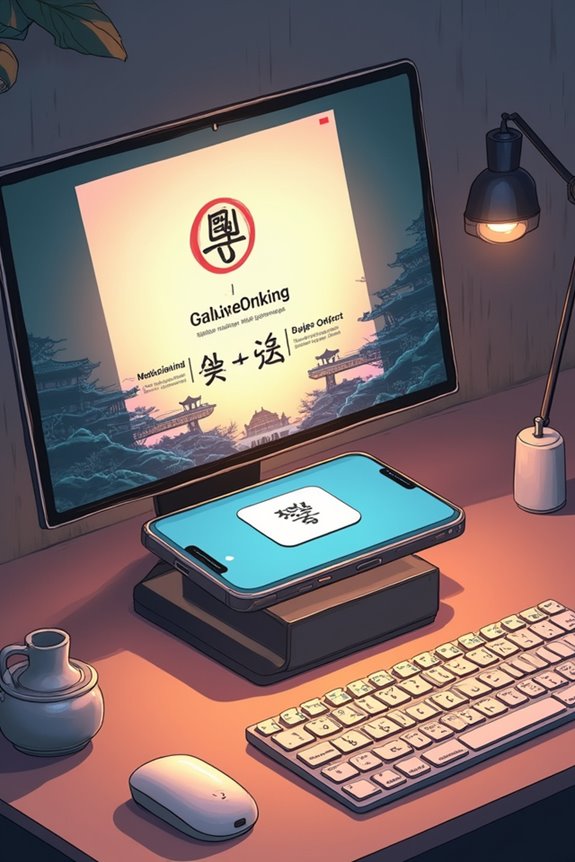Korean language learning presents various challenges that hinder student progress, including high attrition rates, linguistic complexities, and resource scarcity. Many students report dropping out due to scheduling conflicts and difficulties with Korean syntax, pronunciation, and honorific usage. Additionally, access to quality materials is limited, especially in rural areas. Cultural nuances further complicate learning, as understanding indirect communication styles is essential for interaction. By addressing these issues, we can improve the language acquisition experience considerably, and there’s much more to reflect on.
Key Takeaways
- High attrition rates in Korean courses are driven by schedule conflicts, perceived difficulty, and inadequate resources, affecting student retention.
- linguistic complexity, including SOV structure and phonological challenges, makes Korean difficult for learners, complicating sentence formation and pronunciation.
- Resource scarcity and geographic accessibility limit available learning materials and opportunities for practice, particularly in smaller Korean communities.
- Understanding Korean culture is essential, as social norms and indirect communication styles create additional challenges for learners mastering the language.
- Establishing clear, measurable goals and engaging in immersive activities enhance motivation and language acquisition, helping combat high dropout rates.
High Attrition Rates in Korean Language Courses
High attrition rates in Korean language courses present a significant challenge for educational institutions, particularly those in North America. Various attrition factors contribute to this issue, including schedule conflicts and course content that many find too difficult or not challenging enough. Our survey of 129 students revealed that nearly 85% dropped out of their classes during the study period. Issues related to course design, such as inconvenient timing and a lack of supportive resources, play a pivotal role in this high turnover. Additionally, many students reported experiencing language anxiety, which affected their motivation to continue. By addressing these factors, educational institutions can create a more engaging and supportive environment, potentially lowering attrition rates and improving overall student success. Incorporating interactive features into the curriculum could also enhance student engagement and retention.
Linguistic Complexity and Structural Differences

While high attrition rates in Korean language courses highlight the challenges learners face, the inherent linguistic complexity and structural differences of the language also considerably contribute to these difficulties. Korean syntax processing differs fundamentally from English due to its head-final, Subject-Object-Verb (SOV) structure. This, coupled with the absence of relative pronouns, complicates the formation of complex sentences. Honorific usage adds another layer, requiring specific verb endings based on social status, which many learners find intimidating. Additionally, Korean’s phonological distinctions, including lenis and aspirated consonants, complicate pronunciation for non-native speakers. Dialectal variations further challenge comprehension, as vocabulary and pronunciation differ markedly across regions, resulting in issues understanding diverse spoken forms of the language.
Resource Scarcity and Accessibility Issues

Accessing resources for Korean language learning can be challenging, particularly when we consider the limited availability of textbooks, materials, and community support. Compared to more commonly taught languages, the resource availability for Korean is lower, which affects our learning journey. For many of us, geographic accessibility plays a significant role as Korean courses are primarily offered in urban areas. In regions with smaller Korean communities, opportunities for language meetups and cultural events are often scarce. While online resources can help bridge this gap, internet access limitations in some areas may hinder our ability to utilize these tools effectively. Consequently, as learners, we frequently encounter obstacles that complicate our pursuit of fluency and comprehension in the Korean language. Moreover, the lack of structured lessons in many available resources can further impede our progress toward effective language acquisition.
Cultural Understanding and Societal Challenges

Cultural understanding is essential for successfully learning Korean, since the language reflects the unique social norms and values of Korean society. Korean communication styles emphasize indirectness and harmony, making it important for us to grasp cultural nuances. For instance, the use of honorifics is critical; failure to use them correctly may lead to misunderstandings or perceived disrespect. Many of us also struggle with non-verbal cues and context-dependent expressions, which are prevalent in daily interactions. Additionally, social rituals like bowing and formal greetings require adjustment, adding to our learning challenges. Without acknowledging these cultural aspects, we risk feeling isolated or misunderstanding social dynamics, which can hinder our ability to connect with both the language and the community around us.
Perceived Practical Benefits of Learning Korean

Learning Korean offers numerous practical benefits that can greatly enhance both personal and professional opportunities. One significant advantage is the access to various career opportunities in South Korea’s leading industries, such as technology, robotics, and digital media. Proficiency in Korean is increasingly valued in international business, particularly within the Asia-Pacific region, and boosts employability in education, tourism, and translation sectors. Additionally, many multinational companies prioritize Korean language skills for roles requiring collaboration with Korean partners. Furthermore, teaching English in Korea often includes free Korean classes, allowing for continuous professional development. Overall, engaging in Korean language learning not only strengthens communication skills but also provides valuable practical applications in today’s competitive job market.
Time Commitment and Effort Required for Mastery
As we commence on the journey to mastery of the Korean language, it is crucial to recognize the substantial time commitment and effort required to achieve fluency. Typically, reaching a basic conversational level demands around three months of dedicated study at about seven to ten hours per week. To become conversationally fluent, we should expect to invest approximately one year of similar efforts. For higher proficiency, like a high intermediate level, around 1,200 hours are necessary. Effective learning strategies, such as consistent daily practice and immersive activities, help accelerate our progress. However, without this significant time investment and consistent effort, mastering Korean could take much longer, leaving us facing challenges in our language-learning journey.
Scheduling Conflicts and Their Impact on Retention
While many of us commence on the journey to learn Korean with enthusiasm and determination, scheduling conflicts frequently emerge as a significant barrier to successful language retention. Research indicates that approximately 70% of language learners cite these conflicts as a primary reason for discontinuation. Inconsistent class attendance due to scheduling issues directly impacts retention of vocabulary, grammar, and pronunciation. To counteract this, institutions can offer scheduling flexibility, such as multiple session options and less conventional class times. Additionally, providing resources like language labs and tutoring services helps mitigate the effects of missed classes. By fostering a consistent learning environment, we can enhance our language retention and address the challenges posed by conflicting commitments, ensuring continued motivation and engagement in our studies.
Influence of Native Language on Learning Korean
Scheduling conflicts create obstacles for many language learners, but another considerable factor in mastering Korean lies in the influence of our native languages on the learning process. Phonological transfer from our native language can make it hard to differentiate and produce unfamiliar Korean sounds. Additionally, grammatical adaptation is often influenced by the structural rules of our first language; for instance, learners from languages with case marking might adapt to Korean particles more easily. However, negative interference occurs when our native syntax clashes with Korean’s subject-object-verb order. Cognitive integration also plays a role, allowing us to apply metalinguistic awareness for understanding Korean grammar. Overall, both positive and negative transfer effects considerably shape our learning experience.
Role of Motivation and Personal Goals in Language Acquisition
Motivation plays an essential role in our journey of acquiring the Korean language, influencing both our engagement level and long-term success. Various motivation types, such as intrinsic and extrinsic, drive our learning approaches. For instance, intrinsic motivation stems from a genuine interest in Korean culture, while extrinsic motivation may come from career aspirations or academic requirements. Additionally, our personal goals greatly impact our persistence; learners with clearly defined objectives linked to cultural exchange or career advancement tend to remain committed. In contrast, vague goals often lead to disengagement. Establishing specific, measurable goals, combined with motivation reinforcement, can foster resilience and reduce anxiety. Recognizing this relationship helps us enhance our language acquisition experience while maneuvering challenges in learning Korean.
The Importance of Immersive Learning Experiences
Building on our understanding of how personal motivations impact language acquisition, engaging in immersive learning experiences greatly enhances our journey in mastering Korean. Immersion thrusts us into authentic communication scenarios, continuously reinforcing our speaking, listening, and thinking skills. By participating in immersive programs, we experience rapid improvements in fluency, pronunciation, and comprehension. Utilizing immersive technology, such as language apps and virtual reality, can further simulate real-life interactions. Additionally, experiential learning through Korean media, music, and cultural activities deepens our understanding of customs and vocabulary. As we navigate these immersive environments, we develop resilience and confidence, essential for overcoming communication challenges. Ultimately, these experiences greatly enrich our language acquisition journey and prepare us for practical applications beyond the classroom. Moreover, engaging with Korean language reading materials can provide essential context and vocabulary that enhance our comprehension skills.
Frequently Asked Questions
What Resources Are Best for Self-Studying Korean Effectively?
When self-studying Korean, we’ve found that using effective materials like online courses and YouTube channels, combined with self-study techniques like flashcards and sentence practices, truly enhances our learning experience and retention.
How Can I Find Language Exchange Partners for Korean Practice?
To find language exchange partners for Korean practice, we can use online platforms like HelloTalk, and join local meetups via Somoim. These options provide great opportunities to connect with fellow learners and native speakers.
What Are Some Popular Korean Language Learning Apps Available?
In our quest for language mastery, exploring popular Korean learning apps reveals amazing app features. User reviews highlight tools like interactive lessons and language exchanges, making our journey fun and engaging while we connect with the Korean language.
How Does Korean Culture Influence Language Learning Specifically?
Korean culture profoundly influences our language learning through cultural nuances and language etiquette. We must navigate honorifics and social contexts, understanding that mastering these elements is essential for effective communication within Korean society.
Are There Scholarships for Studying Korean Abroad?
Think of studying Korean abroad as planting a seed; with the right Korean scholarships and funding opportunities, we can nurture our growth and flourish. Exploring options like GKS and SNU scholarships will help us thrive!





